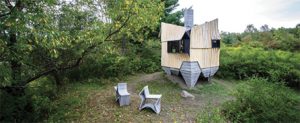HANNAH, founded by Sasa Zivkovic and Leslie Lok, both assistant professors of architecture at Cornell University, has designed and constructed Ashen Cabin, a cabin in rural Upstate New York which features cladding made from infested American ash. Source: Timberbiz
Today, around 8.7 million ash trees in the US are infested by the Emerald Ash Borer, a pest devastating ash trees across the country, and the trees are deemed unusable by most sawmills due to their irregular geometry.
Ashen Cabin explores how these infested ash trees can be used in construction and offers a solution to the environmental impact the disposal of this abundant species has.
“Infested ash trees often either decompose or are burned for energy,” Mr Zivkovic said. “Unfortunately, both scenarios release CO2 into the atmosphere, and so the advantage to using compromised ash for construction is that is that it both binds the carbon to the earth and oysets the harvesting of more commonly used wood species.
“Infested ash trees are a very specific form of ‘waste material’ and our inability to contain the blight has made them so abundant that we can — and should, develop strategies to use them as a material resource.”
The use of infested ash trees is made possible by continuously advancing technologies such as robotics and 3D printing. The team built a custom robotic platform for the sole purpose of processing the irregular ash trees.
“Basically, we begin by creating 3D scans as a basis for translating and digitizing the complex and irregular geometries of the mature trees. The robot is then programmed to cut and process irregular wood geometries — it is through these current technologies that we can work with this material,” Mr Zivkovic said.
With the project, Mr Zivkovic and Ms Lok hope to change how we think about housing and construction in the future, demonstrating how we can use new techniques and underused materials for more sustainable design.
“We believe this prototype oyers a new way to think about the future of home construction,” Ms Lok said. “The cabin is a combination of our design research and thinking in response to the urgent condition of our natural environment and possible modes of intervention and, it demonstrates our potentially replicable use of relatively new technologies that allow us to advance both formal and technological innovation in the [architecture] discipline.”








